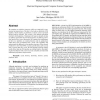Free Online Productivity Tools
i2Speak
i2Symbol
i2OCR
iTex2Img
iWeb2Print
iWeb2Shot
i2Type
iPdf2Split
iPdf2Merge
i2Bopomofo
i2Arabic
i2Style
i2Image
i2PDF
iLatex2Rtf
Sci2ools
MICRO
1994
IEEE
1994
IEEE
A comparison of two pipeline organizations
We examine two pipeline structures which are employed in commercial microprocessors. The first is the load-use interlock (LUI) pipeline, which employs an interlock to ensure correct operation during load-use hazards. The second is the address-generation interlock (AGI) pipeline. It eliminates the load-use hazard, but has an address-generation hazard which requires an address-generation interlock for correct operation. We compare the performance of these two pipelines on existing binaries and on applications which have been recompiled with a local code scheduler that understands the difference in the pipeline structures. When branch prediction is more than 80% accurate and the data cache access time is greater than two cycles, the AGI pipeline performs significantly better than the LUI pipeline on existing binaries. Recompiling the benchmarks with a new local code scheduler provides little additional performance improvement.
| Added | 09 Aug 2010 |
| Updated | 09 Aug 2010 |
| Type | Conference |
| Year | 1994 |
| Where | MICRO |
| Authors | Michael Golden, Trevor N. Mudge |
Comments (0)

